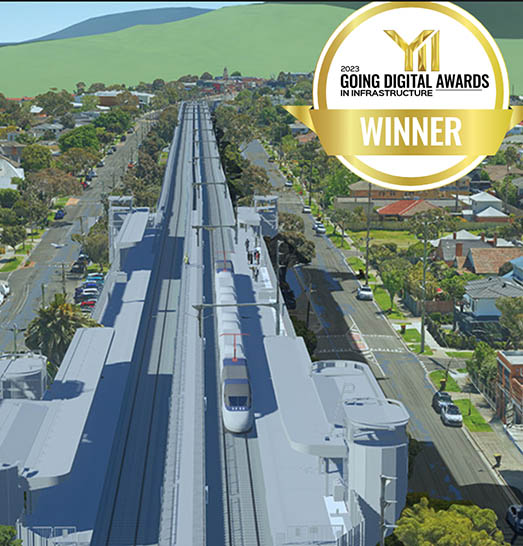At its annual Year in Infrastructure conference, Bentley Systems described 2023 as a “groundbreaking year” for infrastructure intelligence.
Citing users’ projects, Bentley Systems CEO Greg Bentley highlighted in his conference keynote address how infrastructure organizations are overcoming the engineering resource capacity gap through infrastructure intelligence strategies.
When asked to quantify the engineering hours saved through digital advancements, Going Digital Awards finalists reported significant median savings of 18%.
The Going Digital Awards is the highlight of Bentley Systems’ Year in Infrastructure annual conference, held in Singapore in October this year.
Engineering data serves as the foundation and digital twins as the building blocks of infrastructure intelligence. As an indication that digital twins are becoming mainstream, the proportion of Going Digital Awards finalists crediting Bentley’s iTwin platform has risen to 64% in 2023.
In his keynote, Greg Bentley also highlighted multiple infrastructure intelligence strategies that organizations are using to further compound the value of their data, including reusing digital components, integrating subsurface modeling, and incorporating, into evergreen digital twins, operational data from IoT sensors, drones, and even crowdsourcing.
He also explained how Going Digital Awards finalists and organizations in Singapore are accelerating their infrastructure intelligence through the use of AI.
Groundbreaking infrastructure intelligence in Singapore
In Singapore, the location for the 2023 Year in Infrastructure conference, digital twins are extensively used to optimize decision-making and operations:
- PUB, Singapore’s national water agency, is working in collaboration with Bentley Systems on a Singapore National Research Foundation-funded project to develop a new system in detecting and localizing water system anomalies and leaks in near real time. Through a high-fidelity digital twin, AI-based predictive models, and hydraulic network model calibration and simulation, the project could potentially help in improving network resilience and water conservation.
- SMRT Trains, the leading multi-modal public transport operator in Singapore, uses AssetWise Linear Analytics software as the basis for its Predictive Decision Support System to prioritize maintenance. The digital twin system has enabled SMRT to meet its service reliability targets by optimizing maintenance deployments.
- Singapore’s Land Transport Authority (LTA) fully leverages Bentley Systems’ EMME and DYNAMEQ mobility digital twin software for its long-term and short-term planning, including operational traffic models for traffic impact and scheme analysis. This includes using Bentley Systems’ agent-based travel demand model.
- The Singapore Land Authority (SLA) is a leader in digital twin adoption. Dr. Victor Khoo, Director of Survey and Geomatics, SLA, joined the Year in Infrastructure conference to discuss Singapore’s national digital twin journey and share how a 0.225-meter accurate nationwide reality mesh from aerial surveying is incorporated with extensive inputs from other mapping datasets to produce a complete digital twin of the city, which is then shared with multiple agencies and research institutes to support Singapore’s sustainability initiatives.
Accelerating infrastructure intelligence in Asia Pacific
With the iTwin platform, engineering data in Bentley Infrastructure Cloud (ProjectWise for project delivery, SYNCHRO for construction, and AssetWise for asset operations) can be aligned, queried, and managed to increase infrastructure intelligence over the lifecycle of projects and assets.
Bentley Systems estimates that the company’s engineering users accumulate at least 100 million new unique digital components per month within their respective ProjectWise environments, teeing up potential infrastructure intelligence benefits across construction, operations, and maintenance.
Henry Okraglik, Global Director of Digital, WSP Australia, explained the benefits of becoming data-centric through Bentley Infrastructure Cloud: “As we’ve digitally matured, we’ve been able to embrace capabilities from Bentley Infrastructure Cloud to improve construction staging and planning, track and export quantity data across project phases, reduce the need for physical site visits, and a lot more.”
For example, using ProjectWise, SYNCHRO, iTwin, and other Bentley products, WSP — winner of the Going Digital award in the Bridges and Tunnels category for Melbourne’s Southern Program Alliance — was able to reduce modeling time by 60%, increase productivity by 25%, and reduce the carbon footprint by 30% on the rail network project in Melbourne.

Open applications and generative AI
To systematically introduce the benefits of digital twins in the design phase, Bentley Systems announced the addition of iTwin capabilities in Bentley Open Applications, for modeling and simulation, starting with MicroStation.
With iTwin capabilities and workflows natively integrated, Bentley Open Applications will be able to automatically create digital twins during the design process, enabling users to collaborate in real-time, evaluate the impact of changes more seamlessly, reduce rework, and expedite infrastructure intelligence.
Embracing AI’s potential to accelerate infrastructure intelligence, the company highlighted its existing analytical AI capabilities, powered by iTwin, for asset monitoring, and articulated its multi-faceted approach to generative AI for design. This approach is guided by the company’s commitment to help users gain ever more value from their own engineering data secured in Bentley Infrastructure Cloud – maximizing their potential from generative AI, while also ensuring each account retains explicit access and control.
Julien Moutte, Chief Technology Officer, provided examples of generative AI for infrastructure engineering, beginning with an AI agent assisting engineers in further optimizing site layouts by leveraging designs and data from previous projects. He also showed how generative AI can be applied to minimize time spent on project documentation by automating drawing production with fit-for-purpose annotations.
“We believe iTwin-powered generative AI capabilities will support engineers by augmenting the work they’re already doing. We see iTwin becoming a copilot to support better decision-making, reduce repetitive tasks, and increase design quality. It can help close the engineering resource capacity gap – not only by empowering current engineers to produce more, but also by enabling a more rewarding work experience, enticing future engineers to join the community advancing infrastructure,” said Moutte.
